Content
Potatoes of the "Luck" variety fully justify their name. Among domestic potato varieties, this is one of the best. Many summer residents, having experimented with other varieties, opt for this. Purchasing demand for the Udacha potato variety remains consistently high. What are the main characteristics of the variety, what is the secret of its success, popularity and "luck"?
Breeding history
The potato variety "Luck" was bred in the 90s of the last century. The basis of the variety was made up of potatoes "Vilnia" and "Anoka". The breeders set a goal - to achieve the creation of an unpretentious potato variety that gives good yields in different climatic zones with different soils. As practice has shown, agronomists coped with their task perfectly.
Newly baked potatoes "Good luck" have perfectly proven themselves in various regions: from the North-Western regions of Russia to the Black Earth Region, from the Volga Region to the Far East. Its main feature is its high adaptability. The yield per hectare is 40-45 tons even in hot and dry summers.
Description and characteristics
The plant is characterized by powerful 40-centimeter bushes with thick leaves. Leaf shape with a characteristic dissection, color is bright green. The variety does not bloom for long, but abundantly. Inflorescences are collected in small clusters. The flowers are snow-white in color, with sepals bent downwards.
Potato tubers are round and oval in shape, with a small number of eyes. The color of the tubers ranges from yellowish cream to brownish. The tubers of this variety are characterized by a thin and smooth peel, so there are very few peelings during cooking. In its raw form, the flesh of a potato is white; it turns a little yellow when cooked. This is especially noticeable if, when growing the plant, mineral fertilizers were used: potash and chloride.
The characteristics of the potatoes "Luck" are as follows:
- The duration of the growing season is from 80 to 90 days;
- The mass of 1 tuber is on average 150 g;
- The number of tubers per plant is 10-15;
- The percentage of starch is 12-14%;
- Productivity per hectare (on average) - 42 tons;
- Productivity from 1 bush - 1.7 kg;
- The percentage of marketable products - 88-97;
- The taste is excellent.
The yield of the "Luck" potato is influenced by the weather and agricultural techniques, and the type of soil has no particular effect on the yield.
Benefits
The advantages of the variety, which distinguish it from other selection products, are as follows:
- Immunity to low temperatures... For active germination of tubers, an air temperature of plus 10 degrees is sufficient. Potato sprouts thrive in both cloudy and moderately cool weather. The landing date for the central regions is the end of April. Closer to the north, potatoes are planted in mid-May.
- Quick tying of tubers... About 1.5 months after the emergence of shoots, young potatoes are quite edible. The mass of tubers varies from 60 to 80 g. Young potatoes have a pleasant and delicate taste. The yield from 1 hectare after 2 months of growing season ranges from 20 to 25 tons.
- Disease resistance (potato cancer, rhizoctonia, mosaic, scab). Defeat with viral diseases is very rare.
- Excellent keeping quality... When ripe early, potato tubers are perfectly preserved "from harvest to harvest". It is only important to provide normal storage conditions. At the same time, potatoes do not lose their taste.
- Resistance to mechanical stress... The variety is very well suited for mechanical harvesting and transportation.This is especially important if the potatoes are grown commercially.
- Excellent taste characteristics... The tubers are not watery, they are equally well suited for mashed potatoes, baking and frying. This variety is rightfully considered one of the most delicious.
Disadvantages of the variety
First of all, this is insufficient resistance to "potato" diseases.
- Phytophthora.
- Alternaria.
- Golden nematode.
This variety does not like excessive thickening of the rows. However, with the observance of agricultural technology, you simply will not face these problems.
How to grow "Luck"
The main thing that distinguishes the Luck potato from other hybrids and varieties is its unpretentiousness in terms of soils. It grows not only on chernozems, but also on clay soils, loam and sandy loam soils. But potatoes also require a certain amount of care. For example, the beds need to be prepared in the fall. Potatoes grow best after melons, cabbage and cucumbers. If tubers are planted in the same place for a long time, the risk of diseases increases. In addition, the variety is degenerating.
Tubers grow best in soft soil. Therefore, the site intended for planting the variety must be dug in advance to a depth of 2 cm. At the same time, the soil is fertilized with compost or humus, at the rate of 40 to 45 buckets per one hundred square meters.
For clay soils, it is most convenient to plant tubers in pre-formed ridges 15-20 cm high, with a distance between the ridges of 70 cm. With this planting, the soil will warm up better. Its breathability will also increase. For chernozems, planting with "ridges" is not necessary, since the soil warms up well without it.
Landing
The optimum weight of the planting tuber of the "Udacha" variety is from 50 to 80 g. Large potatoes are characteristic of the variety, therefore, each of the tubers is cut so that three or four eyes remain on each part.
For planting, you need to take only healthy potatoes. Tubers with visible signs of disease should be discarded, as there is a risk of getting infected plants.
It is recommended to treat the tubers with wood ash. Ash disinfects and plays the role of potash fertilizer for planting material. Then the potatoes must be placed in one layer in the germination box. The optimum temperature for germination is 16-18 degrees.
The optimal planting time for the Udacha variety, depending on the region, is from the second half of April to mid-May. The distance between the holes within a row is at least 20 cm. The interval between rows is from 30 to 40 cm. To feed the plant, you need to mix compost and wood ash in equal proportions. More feeding is not needed, it is better to feed the bushes during the first hilling.
After the emergence of seedlings, it is advisable to huddle them in order to protect them from possible night frosts. Further care of the plants consists in weeding weeds and loosening the soil. This improves the air supply to the root system. It is best to loosen the soil after the rain before it has dried out.
Potatoes "Luck" loves nitrogen fertilizers, but they need to be fed with great care so that they do not get on the leaves and stems of the plant. In terms of watering, the variety is undemanding, therefore, abundant watering is needed only in severe drought and hot weather.
Pest and disease control
The variety has good disease resistance, but individual diseases should be feared.
Phytophthora
It is manifested by the appearance of dark gray spots on the leaves and stems. The disease affects the entire plant, down to the tubers. They start to rot.
Prophylaxis against late blight can be:
- Compliance with crop rotation.
- Weeding and weeding.
Before the flowers appear, the seedlings are treated with Ridomil (25 g per 10-liter bucket of water).After the flowers appear, use the Hom product (for a 10-liter bucket of 30 g). If infected plants are found, they must be immediately dug up and destroyed.
Stem nematode
A plant affected by a nematode is characterized by increased bushiness. The leaves are colored paler than is typical for the variety. Spots appear on the tubers. Prevention: adding wood ash when planting. If infected plants are found, they must be dug up and destroyed.
Colorado beetle
On plants affected by the beetle, tubers form worse than on healthy ones. Planting plants with a strong smell (calendula, dill) next to potatoes helps. Treatment with such means as Karate, Corado, Tanrek, etc. helps. Before using the drugs, you must carefully study the instructions. And, of course, the tried and tested beetle collection by hand helps. A good protection against the beetle is the addition of wood ash to the holes when planting.
Testimonials
Most of the reviews about the variety are positive.
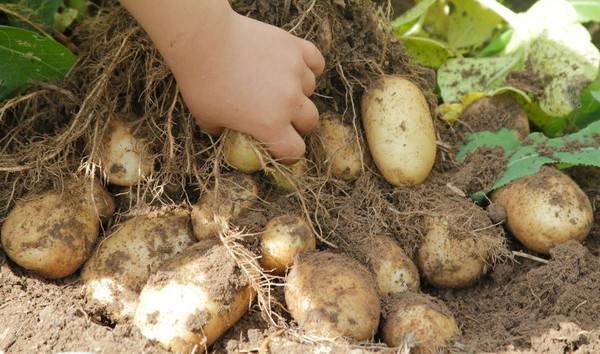
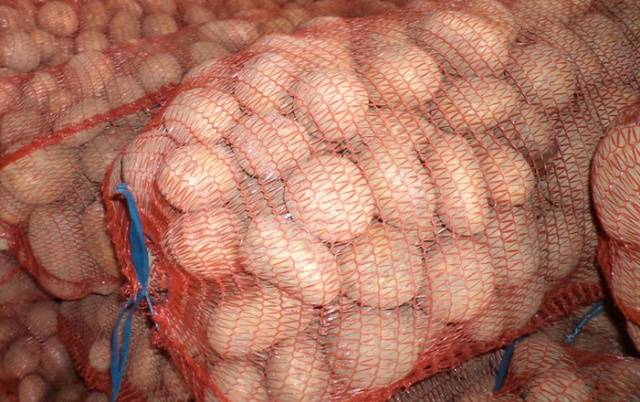
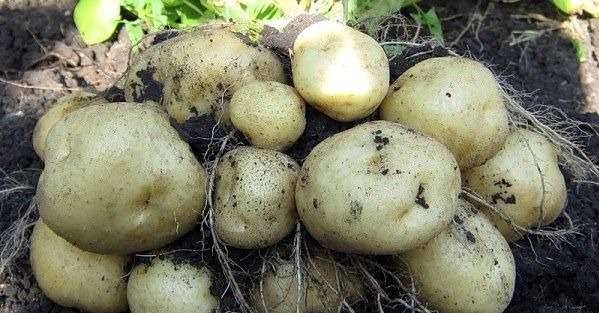
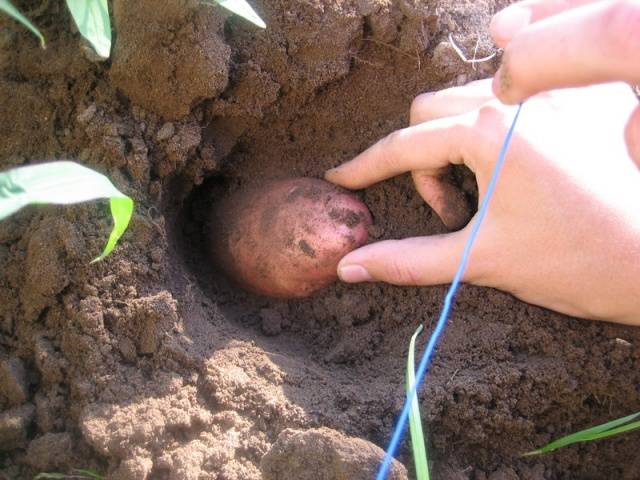
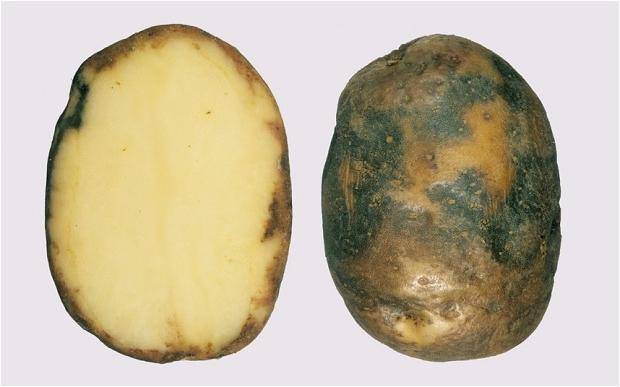
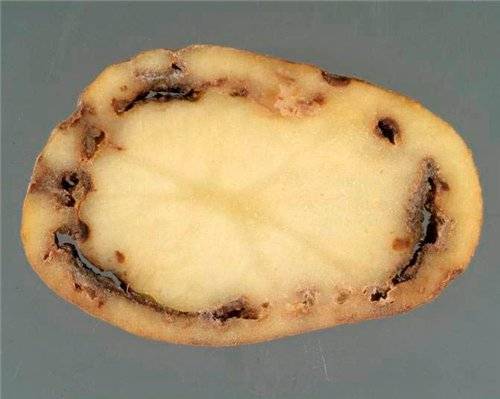

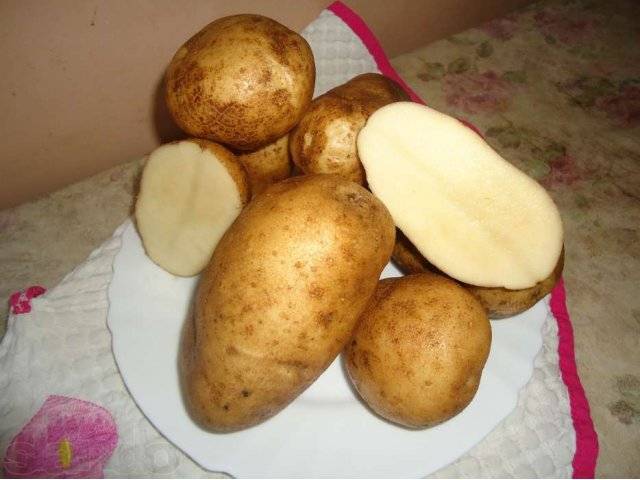









Good day! I bought a variety of luck as an early ripening. I planted 1kg on 04/27/2019, dug 2 buckets on 07/16/2019. A lot of fruitful in the bush, 85% large and medium and 15% small. It is convenient to dig all the potatoes on the bush. The pulp is white, cooked quickly, boiled too lightly, delicious mashed potatoes can be eaten without oil. When frying, the potatoes do not fall apart, they keep the pieces intact. I left a good variety for breeding. I will plant earlier next year.
I bought it at the market for food. The seller praised it: it cooks for 15 minutes, it is very tasty and I will not regret it. And I regretted it. I mostly have a child on mashed potatoes.Boil and bake for an hour and a half. I didn’t like it at all. Bad on mashed potatoes. Not tasty potatoes. Only a dug crop and already covered with white dots under the skin. I won't take this anymore
My dears, and I planted a car this year. Good luck, and for two months now, the bushes are good and there are no signs of blooming yet. There are not even buds. The husband swears.